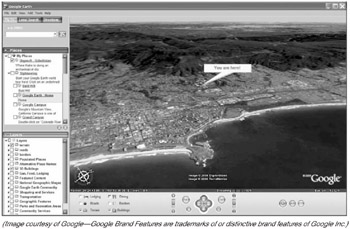Chapter 1: A Brief History of Location Services and Concepts
Overview
The history of applications for location information is as long as human history. Maps, street signs, and even the most basic of symbols scratched in stone to indicate the nearby presence of a waterhole are all examples of location-related information being brought to bear for the benefit of users. In more recent times, location-based applications have been commonly implemented on electronic communications networks. Even before cellular networks contained a specific infrastructure for providing location information directly to applications, such applications existed. For example, POTS-based 1-800 services would refer to a database relating the caller's number to their location so that the call would be routed to the nearest franchise associated with the dialed number. People have been assisted in contacting their nearest pizza restaurant in this way for many years-probably without giving that fact much thought. Taxi and courier companies have also, for many years, utilized GPS receivers located in vehicles coupled with a public or private wireless data connection to a home-base in order to track, schedule, and dispatch vehicles in an optimal fashion (see Figure 1.1).

Figure 1.1: A vertical fleet application showing vehicle GPS, network, and application server.
Most recently, the media-rich capabilities of the Internet have created an enormous new scope for location-based services, and this is the key focus of this book. The vast quantity and range of content available over the Internet and World Wide Web can only be digested if there are mechanisms to sort the relevant from the irrelevant so that the information is customized to the needs of the user. This has been the motivation for the evolution of Internet search engines over the past decade. A significant parameter used in the refinement of Internet searches and content delivery is geographic location. For example, business directory services may be requested based on those servicing a particular city, or a list of movies showing in cinemas within a ten-kilometer radius may be asked for.
Mapping applications have become a commodity Internet service and it is common practice for travelers to obtain maps and driving directions from any of the many web-based services that provide this data based on the location information provided by the user. Most recently, the popularity and attention given to applications such as Google Earth™ demonstrates the interest that the general population of Internet users have in accessing information about the physical and spatial world they inhabit.
A function that, with little exception, all of these applications benefit from is the ability to automatically identify the location of the user rather than have the user manually provide the location information when needed. That is, there is a need for a mechanism that can provide the "You are here" feature to location-based Internet services, as suggested in Figure 1.2. It has long been the case that users can reach services from more than just a single point of access to the Internet. That is, users are able to be nomadic and access the Internet from multiple and relatively arbitrary locations. For example, they may use a map service from home one day and then 24 hours later use the same service from a city on the other side of the country. Clearly the driving directions to a given destination will be quite different for the two points of origin. In this example, there are obvious benefits if the user does not have to manually provide the point of origin, not least because they may not even know the address associated with their new location.

Figure 1.2: Adding the "You are here" to Internet applications.
In addition to the nomadicity associated with users of the Internet, there is a growing trend toward fully mobile access. The deployment of 3G cellular networks supporting always-on high-speed connections as well as newly introduced wireless broadband technologies such as WiMAX allows users to be in constant connection with Internet services while they are in motion. The assumption of a static location associated with a user becomes increasingly invalid as this trend develops. By the same token, the frequent manual updating of location by users becomes increasingly impractical if they are continually moving. A mechanism by which an IP device can automatically obtain location information to provide to applications of the user's choosing becomes essential.
While no ubiquitous and consistent infrastructure exists for the automatic provision of location information in the Internet today, there is a precedent for this functionality in modern communications networks. The major standards for cellular telephony and 3G networks define a location services infrastructure. Driven largely by the imperative to support automatic location determination for the North American emergency (E911) service, these specifications have been almost universally implemented and the majority of modern cellular networks are now equipped with the ability to provide the automated location determination of cellular devices and the delivery of that location information to applications.
EAN: 2147483647
Pages: 129